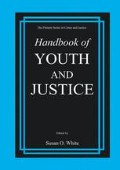Abstract
The history of juvenile justice reforms in the United States and many other parts of the Western world is an uneven one (Sutton, 1988). Reforms that brought about juvenile justice are a consequence of modern-day efforts to deal with the most stubborn and defiant juveniles. Although troubled juveniles and juvenile crime have always existed, what has changed is the manner in which officials are able to deal with misbehaving juveniles. The intractable problem of what to do with the delinquent has produced solutions that go beyond the child, the family, or the community. Modern-day responses draw on ever more complex institutional responses that stretch considerably beyond the political and organizational limits of a traditional juvenile court and its system of justice.
Access this chapter
Tax calculation will be finalised at checkout
Purchases are for personal use only
Preview
Unable to display preview. Download preview PDF.
References
Benard, T. J. (1992). The cycle of juvenile justice. New York: Oxford University Press.
Bishop, D. M., & Frazier, C. E. (1991). Transfer of juveniles to criminal court: A case study and analysis of prosecutorial waiver. Notre Dale Journal of Law, Ethics and Public Policy, 5, 281–302.
Cohen, S. (1985). Visions of social control. Oxford, England: Blackwell.
Colomy, P., & Kretzmann, M. (1995). Projects and institution building: Judge Ben B. Lindsey and the juvenile court movement. Social Problems, 42, 191–215.
Cressey, D., & McDermott, R. A. (1973). Diversion from the juvenile justice system. Ann Arbor: National Assessment of Juvenile Corrections, University of Michigan.
Emerson, R. (1981). On last resorts, American Journal of Sociology, 87, 1–22.
Fagan, J., & Deschenes, E. P. (1990). Determinants of judicial waiver decisions for violent juvenile offenders. Journal of Criminal Law and Criminology, 81, 314–347.
Feld, B. C. (1984). Criminalizing juvenile justice: Rules of procedure for the juvenile court. Minnesota Law Review, 69, 141–276.
Feld, B. C. (1987). Criminal law: The juvenile court meets the principle of the offense: Legislative change in juvenile waiver statutes. Journal of Criminal Law and Criminology, 78, 471–533.
Feld, B. C. (1990). Bad law makes hard cases: Reflections on teen-aged axe-murderers, judicial activism, and legislative default. Law and Inequality: A Journal of Theory and Practice, 8, 1–101.
Foucault, M. (1977). Discipline and punish: The birth of the prison. New York: Pantheon Books.
Garland, D. (1985). Punishment and welfare: A history of penal strategies. VT: Gower.
Giddens, A. (1991). Modernity and self-identity. Cambridge, England: Polity Press.
Glassman, R. B. (1973). Persistence and loose coupling in living systems. Behavioral Science, 18, 83–98.
Hagan, J., & Leon, J. (1977). Rediscovering delinquency: Social history, political ideology and the sociology of law. American Sociological Review, 42, 587–598.
Hamparian, D., Estep, L. K., Muntean, S. M., Priestino, R. R., Swisher, R. G., Wallace, P. L., & White, J. L. (1982). Major issues in juvenile justice information and training youth in adult courts: Between two worlds. Washington, DC: US Department of Justice.
Jackson, B. (1984). Law and disorder: Criminal justice in America. Urbana: University of Illinois Press.
Jacobs, M. D. (1990). Screwing the system and making it work. Chicago: University of Chicago Press.
Kent v. United States, 383 U.S. 541, 555 (1966).
Krisberg, B., and Austin, J. (1993). Reinventing juvenile justice. Thousand Oaks, CA: Sage.
Levine, M., & Levine, A. (1992). Helping children: A social history. New York: Oxford University Press.
Lindsey, B. B. (1925). Colorado’s contribution to the juvenile court. In J. Addams (Ed.), The child, the clinic, the court (pp. 274–290). New York: Johnson Reprint Corp. (Reprinted 1970).
Mack, J. (1909). The juvenile court. The Harvard Law Review, 23, 105–126.
Matza, D. (1964). Delinquency and drift. New York: John Wiley.
Mennel, R. B. (1973). Thorns and thistles: Juvenile delinquents in the United States, 1825–1940. Hanover: The University of New Hampshire Press.
Meyer, J. W, & Rowan, B. (1977). Institutionalized organizations: formal structure as myth and ceremony. American Journal of Sociology, 83, 340–363.
Miller, J. G. (1979). The revolution in juvenile justice: From rhetoric to rhetoric. In L. T. Empey (Ed.), Future of childhood and juvenile justice (pp. 66–111). Charlottesville: University Press of Virginia.
Mohr, L. B. (1976). Organizations, decisions, and courts. Law and Society Review, 10, 621–642.
Morris, A., & Giller, H. (1987). Understanding juvenile justice. London: Croom Helm.
Osbun, L. A., & Rode, P. A. (1984). Prosecuting juveniles as adults: The quest for “objective” decisions. Criminology, 22, 187–202.
Piatt, A. M. (1977). The child savers: The invention of delinquency, 2nd ed. Chicago: University of Chicago Press.
Rothman, D. J. (1980). Conscience and convenience: The asylum and its alternatives in progressive America. Boston: Little Brown.
Singer, S. I. (1996). Recriminalizing delinquency: Violent juvenile crime and juvenile justice reform. New York: Cambridge University Press.
Sutton, J. R. (1988). Stubborn children: Controlling delinquency in the United States, 1640–1981. Berkeley: University of California Press.
Weick, K. E. (1976). Educational Organizations as Loosely Coupled Systems. Administrative Science Quarterly, 21, 1–19.
Author information
Authors and Affiliations
Editor information
Editors and Affiliations
Rights and permissions
Copyright information
© 2001 Springer Science+Business Media New York
About this chapter
Cite this chapter
Singer, S.I. (2001). Juvenile Court and Its Systems of Juvenile Justice. In: White, S.O. (eds) Handbook of Youth and Justice. The Plenum Series in Crime and Justice. Springer, Boston, MA. https://doi.org/10.1007/978-1-4615-1289-9_18
Download citation
DOI: https://doi.org/10.1007/978-1-4615-1289-9_18
Publisher Name: Springer, Boston, MA
Print ISBN: 978-1-4613-5480-2
Online ISBN: 978-1-4615-1289-9
eBook Packages: Springer Book Archive

